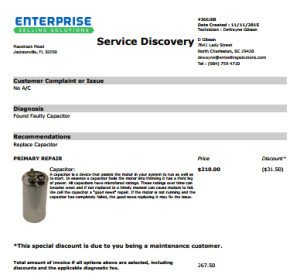Topic number 2 – SERVICE FLAT RATE PROGRAM
Our previous topic was how to build a maintenance program within your company. Just like a savings account planned maintenance customers are there when you need work. So if PMA’s are savings, that would make your service department your checking account.
I hear from dealers on a weekly basis that their customers are turning to the internet to value the parts or services their customers are receiving from them.
Flat Rate
Dealers that are still on a time and materials type of billing are missing out on the ability to truly get what their value is. Most HVAC contractors have rolling fleets of technicians that are worth a LOT of money. Let’s say a truck costs $30k, and you pay your technician $30/hour (Loaded labor). You give that technician two weeks of vacation. So they only work 50 weeks out of the year. Now, Lets say you use the KPI of Tech labor percentage is 22% or less. That tech would generate $272k in service revenue for you. If you divide the $272k by 2000 working hours you get an hourly rate of $136 per hour.
What is the Problem?
Most dealers that are on time and material basis for revenue cannot put $136 on the ticket. The customer will ask, “Who do you think you are, a doctor?” When in truth if you feel like you are a professional, like a doctor, you should at least be getting $136 to $200 per hour. A doctor will not drive to your location with five to ten thousand dollars worth of inventory to make sure you are comfortable. You have to go to them.
Switch to Flat Rate
With Flat rate, we take the cost of the part, and the cost of the labor and formulate a price that will encapsulate and present ONE price to the customer for the repair. In this format the customer doesn’t have to worry about how much time the technician is at their home. The formula is
The cost of the part ($10)
The markup for that part (600%)
The labor to perform the repair (1 hour)
The labor rate of the company ($150)
So in this case the customer pays $210 for the part, and whatever the cost of the Diagnostic Fee. In this case it is $89. The customer would get a discount if they had a maintenance agreement with the company.
The Formula and Calculation
Capacitor $10 x 600% = $60
Labor $150 x 1 = $150
Cost of part = $60
PLUS
Cost of Labor $150
TOTAL REPAIR – $210 plus the diagnostic fee
The Misnomers
There are a few misnomers when it comes to Flat Rate pricing.
1. “Flat rate means I am taking advantage of my customer by overcharging them.”
The reality is you can set your labor rate wherever you wish. If you must bill at $65 an hour, you can set that as your rate.
2. “My technician won’t work as fast.”
This can be true to some degree because the customer now doesn’t care how long the repair takes. This ends up moving the management of the technician back to the company, or the service manager.
3. “My customer won’t accept the change.”
[one_third][/one_third]Not true… Consumers are used to buying based on flat rate. No one gets their oil changed and asks how much the oil costs. Or buys a car and wants to know how much the engine costs. Your customer will be okay. Will some question your technician? Of course. But it still is a better situation than time and materials.
The Proof to go DIGITAL.
It is proven that people will pay more when viewing an HVAC solution on a digital device. Having the solution to appear on a nice screen with images, descriptions, and seeing everything well written, and calculated properly entices the customer to choose the right solution for their needs.
So whether you use ESS’s flat-rate program, or another solution, you, your technicians, and your customers will appreciate the professional look that will be accompanied by that professional job that you are going to do for them.
